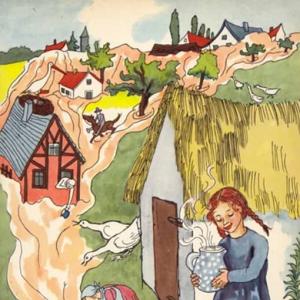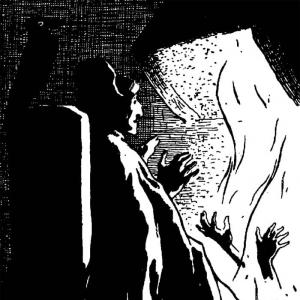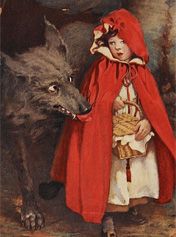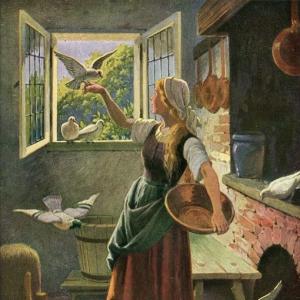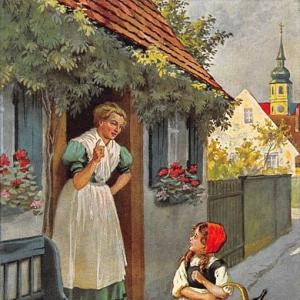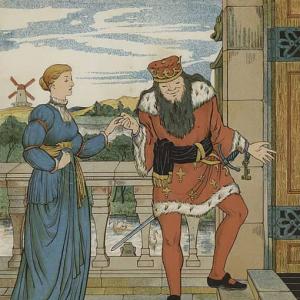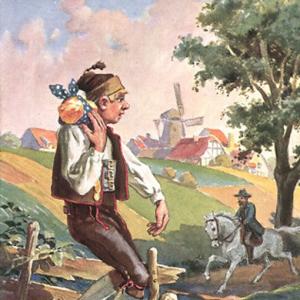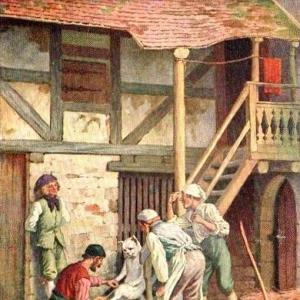Reading time: 4 min
A father was one day sitting at dinner with his wife and his children, and a good friend who had come on a visit was with them. And as they thus sat, and it was striking twelve o’clock, the stranger saw the door open, and a very pale child dressed in snow-white clothes came in. It did not look around, and it did not speak; but went straight into the next room. Soon afterwards it came back, and went out at the door again in the same quiet manner. On the second and on the third day, it came also exactly in the same way. At last the stranger asked the father to whom the beautiful child that went into the next room every day at noon belonged? „I have never seen it,“ said he, neither did he know to whom it could belong. The next day when it again came, the stranger pointed it out to the father, who however did not see it, and the mother and the children also all saw nothing. On this the stranger got up, went to the room door, opened it a little, and peeped in. Then he saw the child sitting on the ground, and digging and seeking about industriously amongst the crevices between the boards of the floor, but when it saw the stranger, it disappeared. He now told what he had seen and described the child exactly, and the mother recognized it, and said, „Ah, it is my dear child who died a month ago.“ They took up the boards and found two farthings which the child had once received from its mother that it might give them to a poor man; it, however, had thought, „Thou canst buy thyself a biscuit for that,“ and had kept the farthings, and hidden them in the openings between the boards; and therefore it had had no rest in its grave, and had come every day at noon to seek for these farthings. The parents gave the money at once to a poor man, and after that the child was never seen again.
 Learn languages. Double-tap on a word.Learn languages in context with Childstories.org and Deepl.com.
Learn languages. Double-tap on a word.Learn languages in context with Childstories.org and Deepl.com.Backgrounds
Interpretations
Adaptions
Summary
Linguistics
„The Stolen Farthings“ is a fairy tale collected by the Brothers Grimm, who were German scholars, linguists, and cultural researchers named Jacob and Wilhelm Grimm. The Brothers Grimm are best known for their collection of fairy tales, which they compiled from various oral and written sources to preserve and share the cultural heritage of their time. Their work, known as „Grimms‘ Fairy Tales“ or „Children’s and Household Tales,“ was first published in 1812 and has since become a significant part of Western folklore and literature.
The Brothers Grimm were part of the German Romantic movement in the early 19th century, which sought to reconnect with the past and explore the cultural and historical roots of the German people. As a result, their collection of fairy tales contains stories that often reflect the morals, beliefs, and customs of the time and the German-speaking regions where they were collected.
„The Stolen Farthings,“ like many other tales collected by the Brothers Grimm, features supernatural elements and moral lessons that were prevalent in the oral storytelling traditions of the era. The story’s themes of generosity, selflessness, honesty, and redemption, as well as its portrayal of restless spirits, are typical of the time and culture from which it was derived. The tale serves as both a reflection of historical and cultural beliefs and a timeless reminder of the importance of moral and ethical behavior.
„The Stolen Farthings“ offers several interpretations that can be drawn from the story:
Moral lesson on generosity and selflessness: The tale can be viewed as a moral lesson on the importance of generosity and selflessness. The child’s decision to keep the farthings for itself rather than give them to a poor man, as instructed by its mother, led to unrest in the afterlife. By giving the farthings to a poor man, the parents ultimately allowed the child’s spirit to find peace. This lesson emphasizes the value of thinking of others and sharing our resources with those less fortunate.
Consequences of dishonesty: The story also highlights the consequences of dishonesty. The child’s choice to keep the farthings and hide them, rather than being truthful and using them for their intended purpose, led to its inability to rest in peace. This interpretation emphasizes the importance of being honest in our actions and intentions.
Parental guidance and responsibility: The tale underscores the role parents play in guiding their children towards moral and ethical behavior. The child’s mother had initially encouraged the child to give the farthings to a poor man, which was an act of kindness. However, the child’s decision to keep the money demonstrated that parental guidance alone is not always enough to ensure moral behavior. It is also the responsibility of the parents to teach their children the consequences of their actions and to instill values that will guide them throughout their lives.
The power of redemption and forgiveness: The story demonstrates the power of redemption and forgiveness, as the child’s spirit is finally able to find peace once the farthings are given to a poor man. This act of kindness and charity by the parents rectifies their child’s previous wrongdoing, showcasing the power of making amends and finding forgiveness.
Supernatural beliefs and cultural practices: The tale also highlights traditional beliefs in supernatural occurrences, such as the restless spirit of the deceased child returning to resolve unfinished business. This aspect of the story reflects the cultural practices and beliefs of the time when the Brothers Grimm collected and published their fairy tales.
The fairy tale „The Stolen Farthings“ has been adapted in various forms over the years. Here are some notable adaptations:
„The Stolen Pennies“ (1960): This adaptation is a British television drama that retells the story with a modern twist. The protagonist finds a few pennies on the street and takes them to the police station to report the find. However, the police accuse him of theft and send him to jail. The drama highlights the theme of police corruption and the abuse of power.
„The Honest Thief“ (1865): This is a stage adaptation of the story that was performed in the United States in the mid-19th century. The play adds new characters and plot elements to the original story, including a love interest for the protagonist and a comic sidekick. The play was popular in its time and was performed in theaters across the country.
„The Thief of Bagdad“ (1940): This is a Hollywood movie that was loosely based on the story of „The Stolen Farthings.“ The movie tells the story of a thief who is wrongly accused of stealing a valuable gem and sets out to clear his name. The movie was a commercial and critical success and is regarded as a classic of the fantasy adventure genre.
„The Stolen Farthings“ (2017): This is a children’s book adaptation of the story by author Jacqueline Jules. The book tells the story in a simplified form and adds colorful illustrations to bring the tale to life for young readers.
„Honesty“ (2003): This is an episode of the television series „The Storyteller,“ which retells the story of „The Stolen Farthings.“ The episode features puppetry and live-action segments and adds new elements to the original story, such as a magic apple that plays a key role in the plot.
„The Stolen Farthings“ is a fairy tale by Brothers Grimm about a family who is visited by a mysterious, pale child every day at noon. The family consists of a father, mother, their children, and a visiting friend. The child, dressed in snow-white clothes, silently enters their home, goes into the next room, and leaves in the same manner. This occurs for three days in a row, piquing the curiosity of the visiting friend.
The friend asks the father about the child, but the father claims to have never seen it. The next day, the friend points out the child to the father, who still can’t see it, along with the mother and the other children. The friend decides to investigate, opening the door to the room where the child had been entering. He witnesses the child searching diligently among the crevices between the floorboards before it vanishes upon noticing him.
The friend describes the child’s appearance and actions to the family, and the mother recognizes it as her deceased child who had passed away a month ago. They decide to remove the floorboards and discover two farthings hidden within the crevices. The child had received these coins from its mother to give to a poor man but had kept them for itself, thinking it could buy a biscuit. This action had caused the child unrest in its grave, prompting it to return daily to search for the coins.
The parents give the farthings to a poor man, and the child never appears again, finally finding peace in the afterlife.
A linguistic analysis of „The Stolen Farthings“ by the Brothers Grimm involves examining the language and narrative style of this short fairy tale, which reflects several common themes and motifs of Grimm tales.
Here’s a breakdown of the key linguistic features and themes:
Structure and Narrative Style
Simplicity and Clarity: The language used is straightforward, characteristic of oral storytelling traditions intended for a wide audience, including children. The narrative progresses linearly, making it easy to follow.
Repetition: The tale uses repetition, a common device in oral storytelling for emphasis and to aid memory. The child’s spirit appearing at the same time and in the same manner over consecutive days creates a rhythm and builds anticipation.
Dialogue: The presence of dialogue, though minimal, is used effectively to reveal character information and propel the narrative forward. The exchange about the unseen child is pivotal in unfolding the mystery.
Themes and Motifs
The Supernatural: The central element is the ghost of a child returning due to unfinished business, a theme prevalent in many folk tales. The supernatural event is presented as matter-of-fact, which emphasizes the fusion of the ordinary and the extraordinary.
Innocence and Redemption: The tale revolves around the innocence of a child who unknowingly commits a wrong and seeks redemption. The child’s ghostly quest for rest serves as a moral lesson about the importance of fulfilling obligations and the purity of intentions.
Moral Lesson: The story conveys a moral lesson typical of Grimm tales, emphasizing virtues like honesty and charity. The act of giving the farthings to a poor man resolves the ghost’s unrest.
Language and Imagery
Descriptive Language: The descriptions are vivid yet concise. The use of imagery, such as the „pale child dressed in snow-white clothes,“ evokes a sense of ethereal purity and innocence associated with the child.
Contrast and Irony: The irony of a small transgression having a significant consequence highlights the moral undertone of the narrative. The story contrasts life and death, visibility and invisibility, innocence and guilt, emphasizing the child’s tragic plight.
Characters and Perspective
Limited Characters: The story is populated by a small number of characters, focusing on the family unit and the stranger, which is typical of fairy tales where a few characters drive the plot.
Third-Person Perspective: The third-person omniscient perspective allows the narrator to provide insights into the actions and thoughts of both the living characters and the ghostly child, facilitating a holistic understanding of the plot.
Overall, the linguistic elements in „The Stolen Farthings“ work together to create a compelling narrative that combines moral instruction with supernatural intrigue, using classic fairy tale techniques that resonate with universal themes of redemption and the fulfillment of moral duties.
Information for scientific analysis
Fairy tale statistics | Value |
|---|---|
| Number | KHM 154 |
| Aarne-Thompson-Uther-Index | ATU Typ 769 |
| Translations | DE, EN, DA, ES, PT, IT, JA, NL, PL, RU, TR, VI, ZH |
| Readability Index by Björnsson | 39.3 |
| Flesch-Reading-Ease Index | 73.4 |
| Flesch–Kincaid Grade-Level | 9.7 |
| Gunning Fog Index | 12.4 |
| Coleman–Liau Index | 7.6 |
| SMOG Index | 9.2 |
| Automated Readability Index | 10.8 |
| Character Count | 1.806 |
| Letter Count | 1.398 |
| Sentence Count | 13 |
| Word Count | 351 |
| Average Words per Sentence | 27,00 |
| Words with more than 6 letters | 43 |
| Percentage of long words | 12.3% |
| Number of Syllables | 440 |
| Average Syllables per Word | 1,25 |
| Words with three Syllables | 14 |
| Percentage Words with three Syllables | 4% |

 Facebook
Facebook  Whatsapp
Whatsapp  Messenger
Messenger  Telegram
Telegram Reddit
Reddit